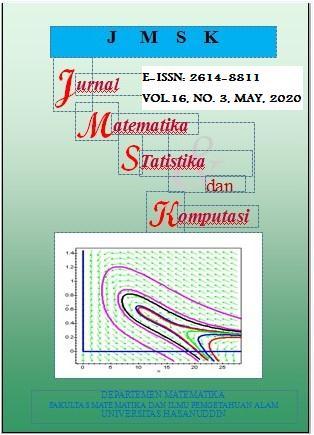Analysis Relationship of Imported Rice with Rice Production, Imported and Domestic Rice Prices with VECM
DOI:
https://doi.org/10.20956/jmsk.v16i3.9436Keywords:
Rice imports, VECM, causalityAbstract
Rice is the main food for most Indonesians. With much natural resources, Indonesia can naturally fulfill its own rice consumption needs. However, Indonesia actually relies on imports to meet consumption needs. Even Indonesia continues to import while rice production is volatility surplus to maintain domestic rice prices. Based on these problems, this study aims to analyze the relationship of volume of imported rice with rice production, domestic rice prices, and prices of imported rice. The method used is descriptive analysis and Vector Error Correction Model (VECM). In the long-term, rice production and domestic rice prices have significant effect on Indonesia's rice import volume. In short-term, rice production and domestic rice prices have significant effect on Indonesian rice import volume. The results of the causality test show that there is a two-way relationship between Indonesian rice import volume and Indonesian production rice. Meanwhile, a one-way relationship occurs when imported rice volumes influenced by prices of domestic rice.
References
Christianto, E., 2013. Faktor Yang Mempengaruhi Impor Beras di Indonesia. Jurnal Jibeka, 7(2), hal. 38-43
Djaenudinm, S., 2018. Impor beras berdampak negatif ke jutaan petani. Sumber: https://ekbis.sindonews.com/read/1342020/34/impor-beras-berdampak-negatif-ke-jutaan-petani-1538115174, diakses tanggal 24 Juni 2019.
Enders, W., 2015. Applied Econometrics Time Series Fourth Edition. New York: John Wiley and Sons, Inc.
Gujarati, D.N. dan Porter, D.C., 2008. Basic Econometrics Fifth Edition. New York: McGraw-Hill, Inc.
Hermanto., 2012. Masyarakat Indonesia makan beras 139kg/orang/tahun. Sumber: http://bangka.tribunnews.com/2012/10/31/masyarakat-indonesia-makan-beras-139-kgorangtahun, diakses tanggal 19 November 2018
Ikhsan, M., 2001. Kemiskinan dan harga beras. hal. 173-209. Dalam A. Suryana dan S. Mardianto. Bunga Rampai Ekonomi Beras. Jakarta: LPEM-Fakultas Ekonomi Universitas Indonesia.
Juanda, B. dan Junaidi., 2012. Ekonometrika Deret Waktu Teori dan Aplikasi. Bogor: IPB Press.
Muchlisin, Z.A. dan Azizah, M.N., 2009. Diversity and Distribution of Freshwater Fishes in Aceh Water, Northern Sumatera, Indonesia. Academic Journal, 5(2), hal. 62-79.
Namira, Y., Nuhung, L.A., dan Najamuddin, M., 2016. Analisis Faktor-Faktor Yang Mempengaruhi Impor Beras di Indonesia. Jurnal Agribisnis, 10, hal. 1.
Pratomo, H.B., 2015. Di era Soeharto, petani Indonesia menjadi penyumbang pangan dunia. Sumber: http://www.merdeka.com, diakses tanggal 27 Maret 2019.
Rungkat, M.D., 2014. Analisis Faktor-Faktor Yang Mempengaruhi Impor Beras di Sulawesi Utara. Jurnal Ilmiah Fakultas Pertanian Universitas Sam Ratulangi, 4, hal. 2.
Suhariyanto., 2018. Jusuf Kalla sampaikan hasil KSA. Sumber: http://www.bps.go.id/news/2018/10/24/245/jk-sampaikan-hasil-ksa.html, diakses tanggal 27 Maret 2019.
Sukirno, S., 2006. Makroekonomi Teori Pengantar Edisi Ketiga. Jakarta: PT Raja Grafindo Perkasa.
Wibowo, S.H., 2005. BPS usul keran impor beras dibuka. Sumber: http://koran.tempo.co/read/50167/bps-usul-keran-impor-beras-dibuka, diakses tanggal 21 Mei 2019.
Downloads
Published
How to Cite
Issue
Section
License

This work is licensed under a Creative Commons Attribution 4.0 International License.
Jurnal Matematika, Statistika dan Komputasi is an Open Access journal, all articles are distributed under the terms of the Creative Commons Attribution License, allowing third parties to copy and redistribute the material in any medium or format, transform, and build upon the material, provided the original work is properly cited and states its license. This license allows authors and readers to use all articles, data sets, graphics and appendices in data mining applications, search engines, web sites, blogs and other platforms by providing appropriate reference.







